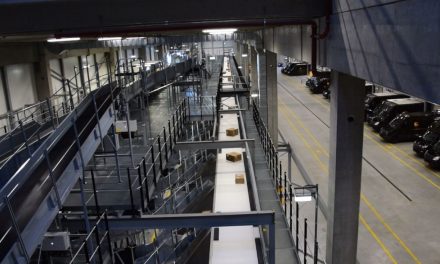
Drop off, pop in and pick up
To have started a company whose very name sums up the market it serves is a privilege enjoyed by few. Yet that’s the situation Jim Doyle finds himself justt two years after starting Collectpoint.
True, othe drop-off poin schemes for home shopping deliveries hay appeared since Collectpoint was founded in December 1999, and some of these survive. But it’s Collectpoint that dominates the market, and whose name springs to mind as soon as the subject is raised.
To recap, Collectpoint has set up a national network of 3,200 delivery points where carriers can leave home shopping or business consignments for recipients to pick up.They are nearly all in convenience stores, most of which are operated by corporate owners or served by large buying groups. You just select a Collectpoint as your delivery address when buying from a participating supplier, then collect the goods from it when they’re ready. Collectpoint takes a very small commission on the deal, and part of that goes to the drop-point operator.
In true entrepreneurial fashion, Jim Doyle recalls the moment when the inspiration for the business came to him: he missed a home delivery because he was in the bath. Whether he shouted eureka is not recorded, but the seeds of an idea were evidently sown.
On a more serious note, in his former role as an IT executive he often worked from home, and had to wait in regularly for document deliveries by UPS. “It completely disrupted my timetable. I decided there just had to be a better way.
“I researched all sorts of options, and soon came to the conclusion that a network of local drop-off points was the answer. But it would be impossible to build a drop-point infrastructure from scratch. Cost and practicality ruled it out.The biggest opportunity lay with the existing retail sector, which already had premises in the right places.”
However, getting support was not easy at first. Although the basic proposition was straightforward enough, Doyle admits that complexity inevitably arose from the number of parties who had to be brought on board. “It tended to be a chicken and egg situation. E-tailers said they didn’t want to commit to the concept until the convenience stores did so. Convenience store chains said the same thing about the e-tailers. And we had to convince carriers and consumers to buy into the concept as well, There was a hesitancy all round.”
For a while his overtures to the store operators got him nowhere, but then T&S (the group behind chains such as Dillons) agreed to run with the scheme. “With about 1,400 outlets, they still form the real core of the network,” he says. Since then many more operators have also been drawn in, including Mills Group, David Sands, Spar, GT News, the Co-op and Londis.
Other priorities
The next task was to attract e-tailers. “Initially some of them took a ‘so what?’ approach,” Doyle says. “Many have now realised that offering the Collectpoint delivery option can help them to sell more, but in the early days they often had other priorities.”
Gradually the company wore them down, though,
and a glance at the Collectpoint site now shows the extent of its success. Among several dozen names are some of the higher-profile names from the e-tail revolution — organisations such as Gadgetshop.corn, Worthaglance.com, Martin Dawes (consumer electronics), Accessories 4 U (mobile phones), Talkingbooks.org and Botham’s (bakery products).The Collectpoint Web site is now effectively a portal for all these companies.
Still missing from the client list (and Doyle frankly admits this) are the national high-street brands that sell online. “But there’s an absolute inevitability about getting the big names involved eventually,” he says. “It’s a matter of timing.”
He feels that some potential users may have hung back because Collecpoint’s public profile is still modest. “To a lot of consumers, we’re still a well-kept secret,” he admits. Yet he seems unperturbed by this. “We’re getting there steadily,” he says. “In the end, consumers will demand our service, and e-tailers will simply have to provide it.”
Wariness about over-promotion was in fact at least partly intentional. “We decided very early on that there was no point in trying to spend massive sums on advertising.Apart from stretching our financial resources beyond the limit, we felt it could actually have a negative effect. There was nothing to be gained by getting consumers to log on to our Web site before there was really anything for them to see.”
Ten million visits
So how does Doyle expect the word to get around? One way is simply through exposure on the ground. “Access to the locations is a big asset,” he says. “There are about ten million visits to convenience stores every week. People see our publicity every time they go in one.”
Another means of promotion is simple word of mouth — and here Doyle sees benefits arising from a recent thrust into the business-to-business sector. Lately Collectpoint has been actively lobbying carriers who deliver materials and components to outbased sales staff and field engineers, and has found lively D
interest from the sector. “And if we handle deliveries for 5,000 engineers who all tell ten people about our service, that’s 50,000 more people who know about us.”
Indeed, to some extent the Collectpoint focus has shifted temporarily from the consumer to the business market. “This is where the core market growth will come in 2002 and 2003,” Doyle believes.
There are several aspects to the appeal of the B2B market, he says. Each B2B contract involves a closed circuit of known recipients, not a random selection of consumers. It’s more manageable. It also provides a ready route for processing returned goods, adding volume and value to the service. And because the gains will be obvious, carriers in particular are considered more likely to embrace the concept than they might be in the consumer sector.
Not that even this market is a walkover, as Doyle is first to admit. “People don’t want to start using a new system unless it answers a real problem.” As a prime example of such a situation, he cites the closure of the Red Star network last year by carrier Lynx. “They were huge in field service deliveries, and had an established network of drop points.” He has also been talking to other carriers, he says, including “a major national player”.
It is a sign of the growing acceptance of the Collectpoint concept that carriers are now apparently beginning to cite the company when writing tenders to prospective customers. “We’re becoming part of the bidding process.”
Meanwhile, another business sector already showing interest in the Collectpoint service is the insurance replacement market. The company is already handling mobile phone deliveries for several such customers. “They don’t even have to be online,” Doyle points out.”These companies do all their business over the phone.”
Sector by sector
Back in the realms of consumer products, Doyle says the company is now tending to attack different markets on a sector-by-sector basis. Lately, for instance, it has been focusing on the drinks business — “Ideal, because cases of wine are too big to carry, and too valuable to leave on the doorstep.” Users already include Buy Wineonline and ItsWine.com.
He says some convenience store operators were initially resistant to holding wine for recipients when they already sold it themselves. “But we pointed out that consumers would never go out and buy a whole case from a convenience store, so there’s actually no conflict. If anything,it makes them more aware that the store sells drinks, so they might go back for a single bottle another time.”
Perhaps surprisingly for such a young company in a pioneering sector, Collectpoint already has an international presence. Early on, it established a relationship with Pickpoint, a German operation in which a major quoted company, D Logistics, owns a 6o per cent share.This now has 2,000 sites in its own country plus a smaller presence in Austria. Last year it was announced that Pickpoint was taking a majority stake in Collectpoint itself, but its share has since settled at io per cent.
Collectpoint is also firmly established in the Irish
Republic, where it has several hundred outlets, and it is hoping to bring Irish post offices into its network. Jim Doyle says by the end of this year there should be partnerships in place in Benelux, France and Scandinavia.” But each market has its own special characteristics; you can’t simply replicate the same concept everywhere.”
The whole drop-off concept was shaken up in the UK last year when Consignia went nationwide with its Local Collect service. Its network of over i6,ooo of its post offices might appear to dwarf Collectpoint’s 3,000-strong offering. However, Jim Doyle seems unfazed by the apparent competition. “Every initiative helps to build up the overall market,”he says, and adds: “Our outlets tend to be open for much longer hours, and have other consumer attractions such as cash machines.”
In any case, Collectpoint is already working with Consignia on its current trials of a range of unattended delivery solutions. “They’re finding we offer an amazing ability to broaden the market.”
That trial also involves various drop-box systems, which Jim Doyle describes as “complementary” to the Collectpoint offering. But he feels they introduce size limitations and raise security issues. “I can’t honestly see how they can ever pay for themselves.” He also regards them as a piecemeal approach to the problem. “Collectpoint can access 22 million households, yet uses an infrastructure with zero capital cost. It’s hard to see how anything can beat that.”
Despite having raced to a leading position in the independent drop-point market, Collectpoint would still like to be busier. “Volumes are reasonable, but we’d like them to be higher,” Doyle says frankly. But he radiates confidence in the long-term prospects. “Internet buying habits will gradually become more entrenched,” he says, “and broadband Internet access will make a big difference. It transforms the online shopping experience.”













